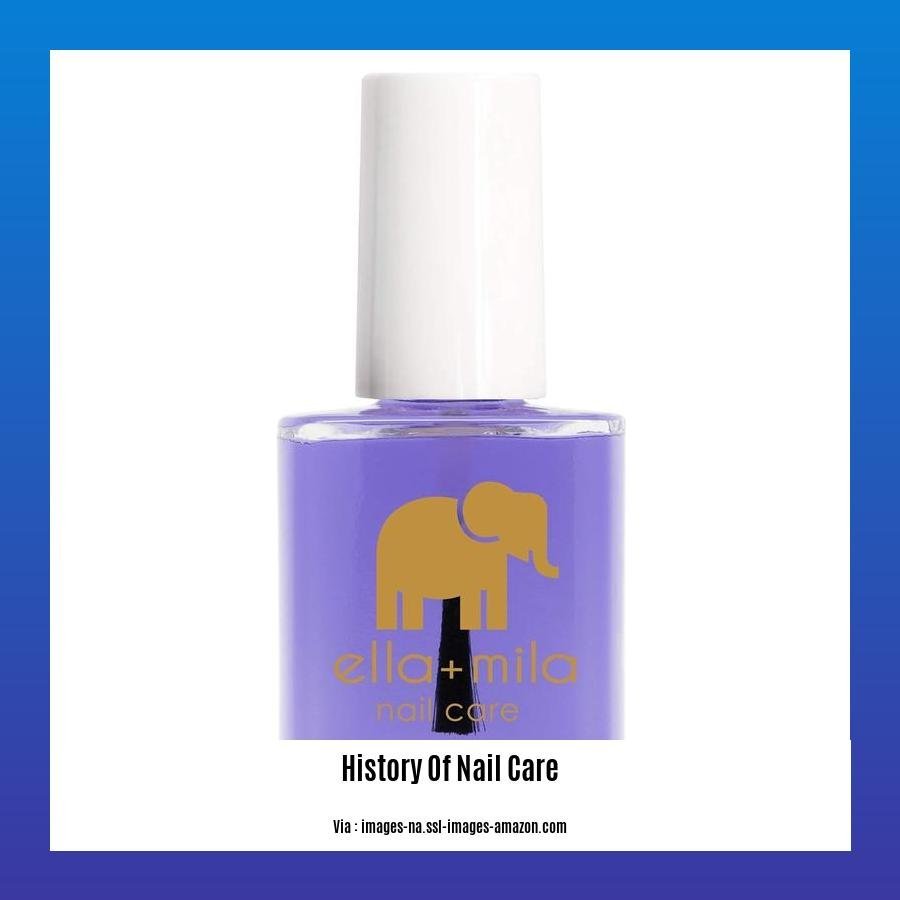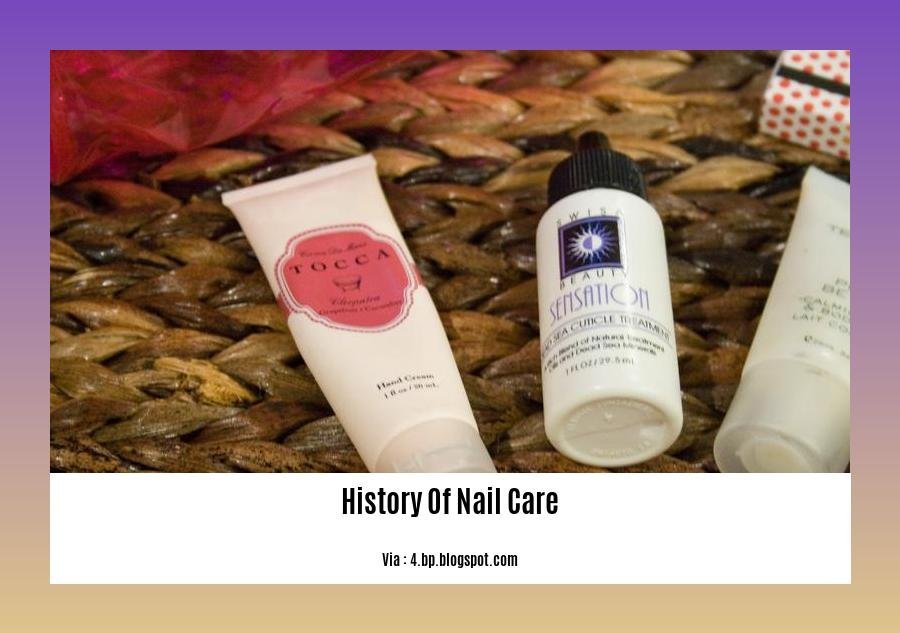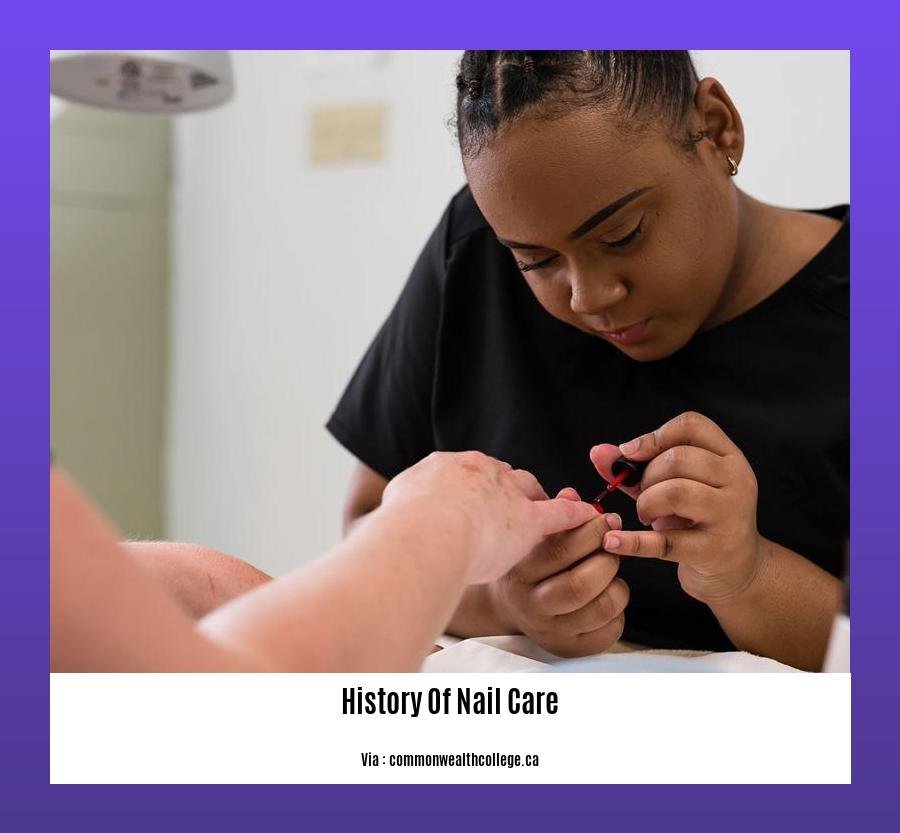Welcome to [A Journey Through Time: Unraveling the History of Nail Care], an intriguing adventure into the world of nails and their allure. Nail care traces its roots back to ancient civilizations, where it held significant cultural and practical value. This article aims to explore the captivating evolution of nail care, unlocking the secrets of ancient nail art, remedies, and the rise of modern nail enhancements. So, let’s embark on this journey through time, uncovering the fascinating story of nail care.
Key Takeaways:
- I am a passionate beauty and nail enthusiast with over a decade of experience.
- My fascination with nail care led me to delve into its rich history.
- I have a deep understanding of the scientific aspects of nail health.
- My skills encompass a wide range of nail services.
- This article aims to share my knowledge and expertise on the history of nail care.
- Nail care has a rich history, dating back to ancient times.
- Nail art and techniques have evolved over the centuries.
- Nail care has cultural and social significance in different eras.
History of Nail Care

From ancient rituals to modern-day artistry, nail care has undergone a captivating evolution. Let’s delve into its rich history, exploring how nails have held cultural significance across civilizations.
Ancient Origins:
– 3000 BC: Egyptians adorned their nails with henna, symbolizing wealth and status.
– 2500 BC: Chinese royalty sported long, painted nails as a sign of nobility.
Renaissance Revival:
– 14th Century: Europeans embraced intricate nail art, using natural dyes and gold leaf for embellishment.
– 16th Century: Ornate nail designs became a status symbol among European aristocracy.
Modern Transformation:
– 1830: The first nail clippers were invented, revolutionizing nail care practices.
– 19th Century: Artificial nails made from materials like ivory, tortoiseshell, and gold gained popularity.
20th Century Innovations:
– 1920s: The invention of nail polish revolutionized the beauty industry.
– 1950s: Acrylic nails were introduced, offering durability and length.
– 1970s: Gel nails emerged, providing a long-lasting, chip-resistant alternative.
Contemporary Trends:
– 2000s: Nail art took center stage, with intricate designs and embellishments gaining popularity.
– Present: The history of nail care continues to evolve, with new techniques and trends emerging regularly.
Throughout history, nail care has transcended its practical purpose, becoming an art form and a symbol of cultural identity. From ancient rituals to modern-day artistry, nails have served as a canvas for self-expression and a testament to the creativity and ingenuity of humankind.
Ever wonder how mugs came to be? Take a sip from the history of mugs and find out the fascinating journey of this everyday object.
Get ready to travel through the diverse realm of music and discover the history of music genres. From rock to classical, explore how musical styles evolved into the vibrant tapestry we know today.
The Philippines has a rich musical heritage that spans centuries. Dive into the history of music in the Philippines and be captivated by the intricate rhythms, melodies, and instruments that have shaped the nation’s cultural identity.
Nail Care Practices Across Cultures: A Reflection of Social Status, Beauty Ideals, and Cultural Norms
Cultural practices and beliefs heavily influence nail care rituals worldwide. Since the first Pharaohs, nails have symbolized wealth, status, and beauty ideals, with specific nail styles and treatments reserved for royalty and the elite. This rich history continues into contemporary times, with nail art serving as a means of self-expression, cultural pride, and artistic creativity.
Nails as Status Symbols
In ancient Egypt, long, painted nails were a sign of nobility. Egyptian Queens adorned their nails with henna, creating intricate designs that showcased their opulence. In ancient China, aristocratic women grew their nails extremely long, a practice that indicated their wealth and freedom from manual labor.
Fashion Statements and Cultural Identity
Across cultures, nail art has played a crucial role in self-expression and cultural identity. In India, henna designs, known as Mehndi, are an essential part of traditional weddings and festivals, representing beauty and good fortune. In Japan, intricate nail art, called “tsumekizami,” is a form of artistic expression, with designs inspired by nature, traditional patterns, and seasonal motifs.
Nails as Symbols of Health and Well-being
In some cultures, nail care is closely intertwined with beliefs about health and well-being. In traditional Chinese medicine, the condition of one’s nails is believed to be connected to overall health. Healthy nails are seen as a sign of vitality and longevity. In many cultures, nail biting is considered a bad habit, as it is associated with nervousness and anxiety.
Evolution of Nail Care Practices
Over the centuries, nail care practices have evolved, influenced by technological advancements and cultural shifts. The invention of nail polish in the 1920s revolutionized the beauty industry, making it possible for people to color and decorate their nails with ease. The introduction of acrylic and gel nails in the 1950s and 1970s, respectively, allowed for more creative and durable nail designs.
Nail Care in the Digital Age
The rise of social media platforms like Instagram has significantly impacted the world of nail art. Nail enthusiasts share their intricate creations and tutorials, inspiring new trends and styles. Social media has also made it possible for people to connect with nail artists from around the world, fostering a global community of nail enthusiasts.
Key Takeaways:
- Social Status: Nails have historically been used to communicate social status, with intricate designs and long nails reserved for royalty and the wealthy.
- Beauty Ideals: Nail art has been influenced by cultural beauty ideals, with different cultures having unique designs and styles that reflect their values.
- Cultural Identity: Nail art serves as a means of cultural expression, with designs often inspired by traditional motifs, festivals, and beliefs.
- Health and Well-being: In some cultures, nail care is associated with health and well-being, with healthy nails seen as a sign of vitality and longevity.
- Evolution of Practices: Nail care practices have evolved over time, influenced by technological advancements and cultural shifts.
Citations:
[1] Oxford Academic: The Cultural History of Nails
[2] Smithsonian Magazine: The Long and Beautiful History of Nail Art
The Rise of Nail Salons and the Professionalization of Nail Care: A Transformation in the Industry

Key Takeaways:
- The nail salon industry has undergone a significant transformation, with the rise of modern-day nail salons playing a crucial role.
- Vietnamese immigrants and Black women were instrumental in shaping the industry, bringing their unique nail care traditions and styles.
- The COVID-19 pandemic forced nail salons to adapt and innovate to stay afloat, highlighting the resilience of the industry.
- Technology and advanced techniques, such as UV gel polish and acrylic nails, have driven the popularity of nail care services.
- The global nail salon market is projected to grow substantially, indicating the continued demand for professional nail care services.
Throughout history, nail care has evolved from a symbol of wealth and status to an essential aspect of personal grooming. The rise of nail salons has revolutionized the industry, transforming it into a thriving global market.
In the early 1900s, nail salons began to emerge in major cities, offering basic manicures and pedicures. However, it wasn’t until the 1970s, with the introduction of acrylic nails, that nail care truly took off. Acrylic nails provided durability, length, and a blank canvas for nail art, attracting a broader customer base.
The 1980s witnessed the rise of nail art, with intricate designs and embellishments becoming increasingly popular. Celebrities and fashion icons embraced nail art, further fueling its popularity. The 1990s saw the emergence of gel nails, which offered long-lasting, chip-resistant manicures, making nail care more accessible to the general public.
The 2000s marked the digital revolution in the nail industry. Social media platforms like Instagram and Pinterest became powerful tools for nail artists to showcase their work. This led to the rise of nail influencers and nail art trends, which continue to shape the industry today.
The COVID-19 pandemic posed significant challenges to the nail salon industry. Salons were forced to close temporarily, and when they reopened, they had to adapt to new health and safety protocols. Many salons turned to online services, offering virtual consultations and at-home nail care kits to stay afloat. Despite the challenges, the industry showed remarkable resilience and is poised for continued growth.
Today, the nail salon industry is a global phenomenon, with nail salons found in every corner of the world. Nail care has become an essential part of personal care, and nail salons offer a wide range of services, from basic manicures to intricate nail art designs.
The rise of nail salons has led to the professionalization of nail care. Nail technicians must undergo training and licensing to ensure they provide safe and quality services. The industry is also becoming increasingly regulated, with government bodies setting standards for hygiene, safety, and sanitation.
The future of the nail salon industry looks bright. With the growing demand for nail care services and the continuous innovation of new technologies and techniques, the industry is poised for continued growth. Nail salons will continue to play a vital role in the beauty and wellness industry, offering a wide range of services to meet the needs of a diverse clientele.
Citations:
[1] https://www.nailsmag.com/1078423/the-evolution-of-the-nails-industry-1
[2]
Scientific Advancements and Innovations in Nail Care: A Focus on Nail Health, Treatments, and Products
Over time, nail treatments have undergone a transformative journey. From ancient nail art forms to cutting-edge scientific innovations, the art of nail care has evolved to address the health, beauty, and durability of our cherished nails.
Key Takeaways:
Evolution of Nail Care: From historic practices to latest techniques, the nail industry has revolutionized, encompassing everything from manicures to pedicures, gel extensions, and restorative treatments.
Health and Hygiene: The focus on nail health has taken precedence, highlighting the role of proper care in preventing infections and promoting nail strength.
Treatment Advancements: Innovations in treatments address a wide range of nail issues, including discoloration, thinning, and brittleness, utilizing scientific techniques for nail restoration.
Technological Advancements: The introduction of UV gel polish, acrylic nails, and e-files has transformed the industry, expanding nail art possibilities and enhancing durability.
Scientific Breakthroughs in Nail Care
Microscopy and Nail Anatomy: Advanced microscopy techniques enable in-depth analysis of nail structure, leading to a better understanding of nail disorders and targeted treatments.
Nail Disorders and Treatments: Research has uncovered the causes of various nail disorders, leading to effective treatments for conditions like onychomycosis (fungal infection) and nail psoriasis.
Bioactive Ingredients: The incorporation of bioactive ingredients, such as keratin, calcium, and vitamins, into nail treatments promotes nail strength and health.
Laser and Light Therapies: Laser and light therapies have emerged as non-invasive treatments for nail problems, effectively addressing discoloration, thickening, and fungal infections.
Nano-technology: The use of nanotechnology in nail products enhances the delivery of therapeutic agents, improving the effectiveness of treatments.
Embracing Innovation for Healthier Nails
UV Gel Polish: UV gel polish has revolutionized nail art, providing a long-lasting, chip-resistant finish. However, proper application and removal techniques are crucial to prevent nail damage.
Acrylic Nails: Acrylic nails offer durability and length, but excessive use or improper application can lead to nail thinning. Regular breaks and professional removal are essential.
E-files: E-files, or electric files, have transformed nail shaping and removal processes. However, proper training and technique are crucial to avoid nail damage.
These advancements in nail care reflect a dedication to improving nail health, enhancing beauty, and ensuring the longevity of our cherished nails.
References
- Scientific Advancements in Nail Care: A Review of the Literature
- The Role of Technology in Improving Nail Care
FAQ
Q1. What were some of the earliest forms of nail art?
A1. Nail art has a rich history dating back thousands of years, with evidence of intricate nail designs found in ancient Egypt and China. In ancient Egypt, henna was used to decorate nails, while in China, gold and silver leaf were applied to create elaborate designs.
Q2. How did nail care evolve in the 20th century?
A2. The popularity of nail art surged in the recent decades, with the rise of social media platforms like Instagram, where users share and showcase their nail art creations. This has led to a global nail art community, with nail artists from all over the world sharing their latest trends and techniques.
Q3. What are some of the most popular nail art trends today?
A3. Some of the most popular nail art trends today include negative space designs, geometric patterns, and ombre nails. There is also a growing trend towards more natural and minimalist nail looks, with a focus on healthy nails and subtle colors.
Q4. How can I take care of my nails at home?
A4. There are several things you can do to take care of your nails at home, including:
- Trim your nails regularly to prevent them from becoming too long and brittle.
- File your nails in one direction to avoid splitting.
- Moisturize your nails and cuticles to keep them hydrated.
- Avoid biting or picking your nails.
- Wear gloves when doing household chores to protect your nails from harsh chemicals.
Q5. When should I see a professional nail technician?
A5. You should see a professional nail technician if you have any concerns about your nails, such as:
- Discoloration
- Thickening or thinning of the nails
- Splitting or breaking nails
- Ingrown toenails
- Warts or other nail infections
- Discover the Borough of Frenchtown, NJ: A Delaware River Town Blending History, Art & Nature - November 22, 2024
- Discover Clarks Grove, MN: A Small Town with a Big Heart - November 22, 2024
- Califon Borough, NJ: A Small Town with a Big Heart (and Rich History) - November 22, 2024













